Laptop Mag Verdict
The HP Pavilion x360 (14-Inch) features strong performance and a comfortable keyboard, but its battery life is a little short.
Pros
- +
Strong performance
- +
Comfortable keyboard
- +
Solid audio
Cons
- -
Below-average battery life
- -
Dull display
Why you can trust Laptop Mag
The latest HP Pavilion x360 borders right on the edge of a premium laptop, offering a strong processor, comfortable keyboard and a good pair of Bang & Olufsen speakers for $749 (starting at $499). This device would be among the best laptops (at least one of the best 2-in-1 laptops) if it wasn't for its short battery life and dull display. Despite that, the Pavilion x360 is a decent machine for the price.
Price and Configuration Options
The base model Pavilion x360 runs for $499 and has a Core i3-8145U processor, 8GB of RAM, a 128GB SSD and a 1366 x 768 display. Meanwhile, the $899 model jam-packs a Core i5-8265U CPU, 12GB of RAM, a 256GB SSD and a 1920 x 1080 screen.
The Pavilion x360 that I tested costs $749 and comes outfitted with an Intel Core i5-8265U processor, 8GB of RAM, a 128GB SSD and a 1920 x 1080 panel.
Design
The hood of the Pavilion x360 is slathered in a warm gold paint, and stamped at the center is a reflective HP logo. The edges of the hood and the deck curve outward and then inward as they meet each other, creating an hourglass design that surrounds the Pavilion x360. There's also a Pavilion logo on the hinge of the laptop.
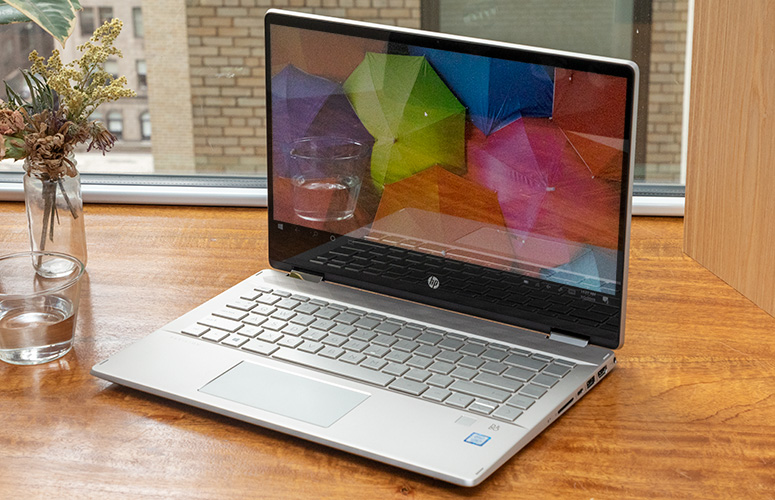
Opening the Pavilion x360 reveals a slightly more silver tone on the deck, a carved out section for the keyboard at the center, and a vent grill for the Bang & Olufsen speakers just above it. There's also a fingerprint reader to the right of the touchpad. Thankfully, the bezels on the display are relatively slim.
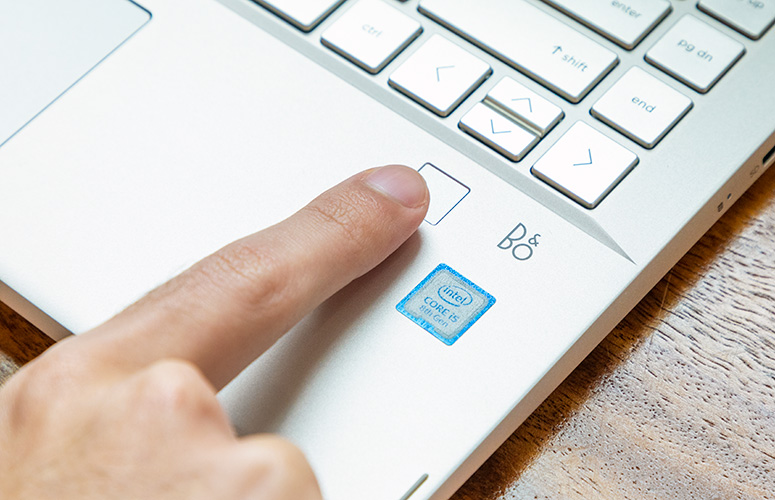
Folding the Pavilion x360 into tent and then tablet mode reveals that the bottom and top parts don't exactly line up. But the bottom is at least magnetic, so it stayed in one position nicely.
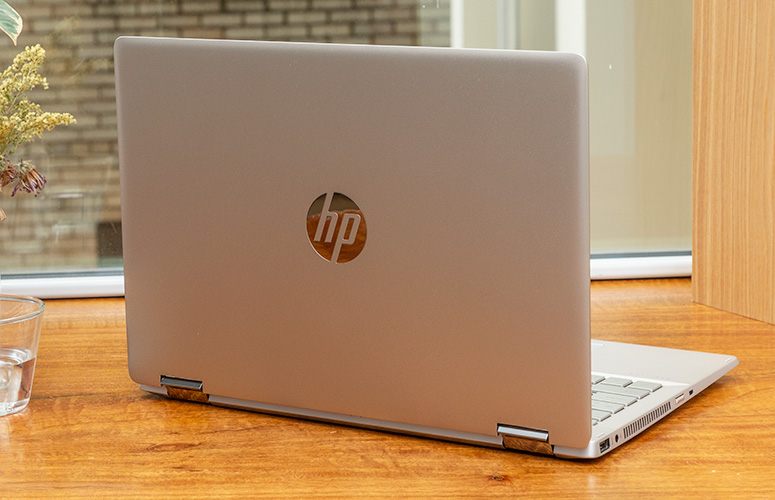
At 3.6 pounds and 12.7 x 8.8 x 0.8 inches, the Pavilion x360 is a bit of a chunker compared to the competition. The Acer Spin 3 comes in at 3.6 pounds and 13.2 x 9.1 x 0.8 inches, while the Huawei MateBook D weighs in at 3.4 pounds and 12.7 x 8.7 x 0.6 inches. The 13-inch alternative, the Asus ZenBook 13 UX333FA, checks in at 2.7 pounds and 11.9 x 7.4 x 0.7 inches.
Ports
There are a decent number of ports on the Pavilion x360, including one USB 3.0 port, a headphone jack, the power button and a security-lock slot, all on the left side.
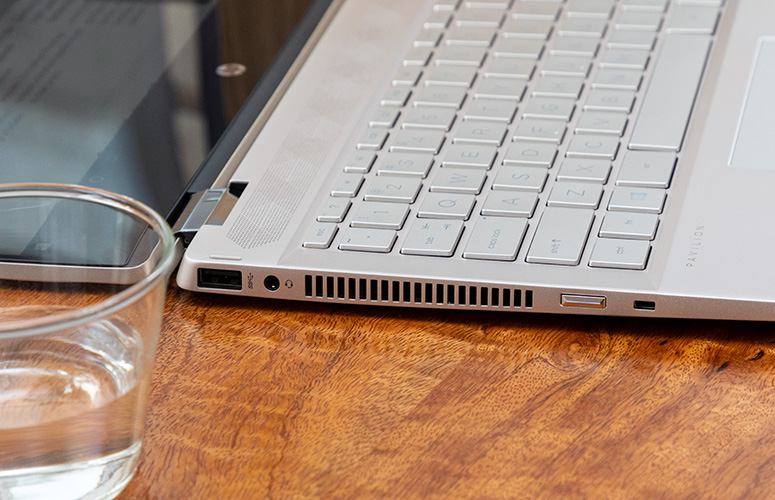
Meanwhile, the right side features the power jack, an HDMI port, one USB 3.0 port, one USB Type-C port and an SD card slot.
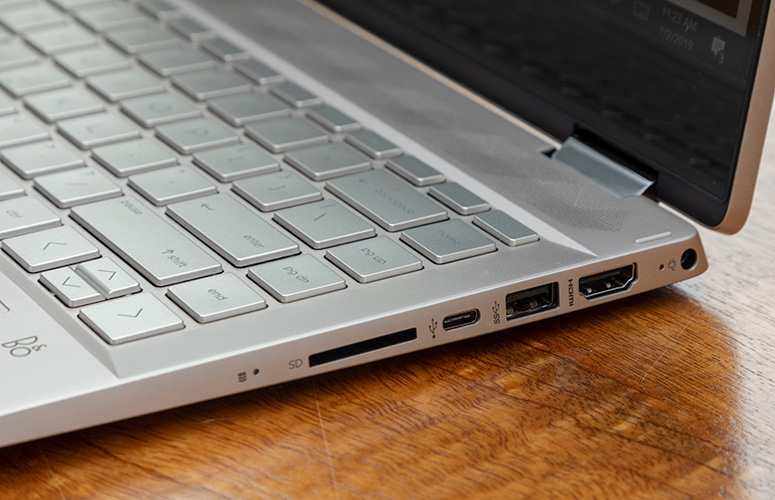
Display
The Pavilion x360's 14-inch, 1920 x 1080 display is a little on the dull side. And while the screen is relatively bright, its glossy texture makes it a little frustrating to look at.
Karen Gillian's red top looked drained in the Jumanji: Next Level trailer on the Pavilion x360's panel. When Gillian was kicking ass in what looked like a dining area, I could see most of the surrounding furnishings, but only at a certain angle, as there was significant glare. Despite that, the display is sharp enough that I spotted the stitching in Jack Black's hat.
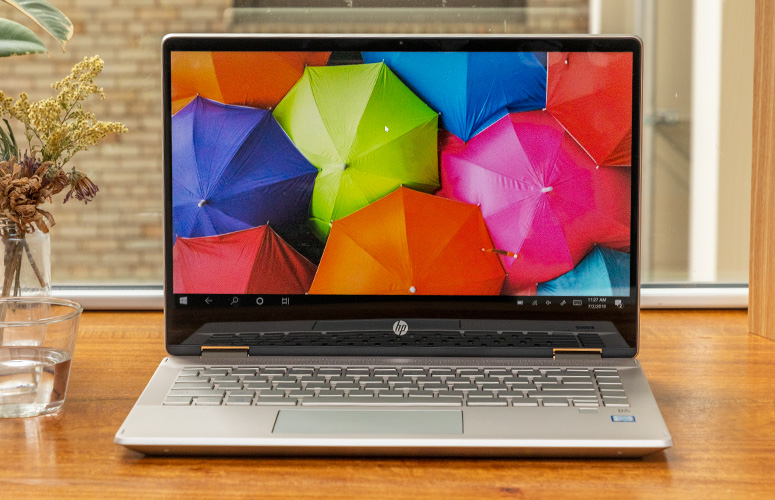
According to our colorimeter, the Pavilion x360 panel covered 61% of the sRGB color gamut, which is duller than the 76% mainstream laptop average, not to mention the Spin 3 (69%), the MateBook D (73%) and the ZenBook 13 (115%).
MORE: The Laptops with the Brightest Displays: Guide
At 261 nits, the Pavilion x360's panel is brighter than the category average (253 nits), as well as the Spin 3 (237 nits), the MateBook D (230 nits) and the ZenBook 13 (225 nits).
Keyboard and Touchpad
Typing on the Pavilion x360's keyboard is immensely satisfying. The keys aren't snappy, but they feel smooth and require a decent amount of force and travel before they hit the bottom.

I sped through 74 words per minute on the 10FastFingers.com typing test, which is faster than my current 70-wpm average. The keys traveled at 1.4 millimeters, which is on the cusp of our preferred 1.5 to 2.0 mm range, and they required a solid 70 grams of force to actuate.
Typing on the Pavilion x360's keyboard is immensely satisfying.
The Pavilion x360's touchscreen panel was responsive as I drew a crude painting of a sunset (a.k.a. five blue lines on top, five green lines on the bottom, and an orange circle at the center - perfection).
The 4.3 x 2.1-inch touchpad has a semi-matte texture that's not as comfortable as the ones installed on the EliteBook line, but it works fine. The pad has Windows Precision drivers, so it handled Windows 10 gestures, such as three-finger tabbing and two-finger scrolling, nicely.
Audio
The Pavilion x360's top-firing Bang & Olufsen speakers are surprisingly good for a sub-$800 laptop. While the speakers could have been slightly louder, they were able to carry Missio's "I See You" throughout a small office. The opening vocals, combined with the keyboard notes, roped me into the moment. And when the drum beats dropped, I could feel the weight of the bass. The overall sound could be brighter, but I've heard worse speakers on $2,000-plus machines.
MORE: 5 Tips for Quality Notebook Audio
The audio benefits from the Bang & Olufsen audio app, which includes presets for Music, Movie and Voice. Within those settings are dials for bass, treble and dialog clarity, as well as a full equalizer.
Performance
Armed with an Intel Core i5-8265U processor and 8GB of RAM, the Pavilion x360 juggled 30 Google Chrome tabs and four 1080p YouTube videos simultaneously without a sweat.

On the Geekbench 4.1 overall performance test, the Pavilion x360 scored 12,495, which is just above the 9,482 mainstream laptop average. It couldn't get past the Spin 3's Core i5-8250U (13,203) or the ZenBook 13's Core i5-8265U (15,110), but it was faster than the MateBook D's AMD Ryzen 5 2500U (8,845).
MORE: Best and Worst Laptop Brands
The Pavilion x360 transcoded a 4K video to 1080p in 21 minutes and 59 seconds on our HandBrake benchmark, which may seem long, but it's a lot quicker than the category average (31:19). However, the Spin 3 (21:09), the MateBook D (21:30) and the ZenBook 13 (20:48) all finished faster.

HP's 128GB SSD copied 4.97GB of data in 41 seconds, translating to 124 MBps, which is only slightly faster than the average mainstream laptop (119 MBps). The MateBook D's 256GB SSD (110 MBps) is a little slower, and the Spin 3's 256GB SSD (145 MBps) ramps up some speed, while the ZenBook 13's 256GB SSD (424 MBps) breaks the sound barrier in comparison.
Graphics
Packed with an Intel UHD 620 GPU, the Pavilion x360 scored 71,938 on the 3DMark Ice Storm Unlimited graphics benchmark, which surpassed the mainstream laptop average (61,258) as well as the performance from the Spin 3's Intel UHD 620 (61,440) and the MateBook D's Radeon Vega 8 (63,302). However, the ZenBook 13's Intel UHD 620 (80,655) outdid the competition.

In real-world testing, the Pavilion x360 ran the Dirt 3 benchmark at 26 frames per second, which is nearly half of the category average (43 fps), not to mention below the 30-fps minimum for playability. On top of that, the Spin 3 (47 fps), the MateBook D (65 fps) and the ZenBook 13 (59 fps) all performed above average.
Battery Life
Unfortunately, the Pavilion x360 doesn't have stellar battery life. After it continuously surfed the web over Wi-Fi at 150 nits of brightness, the battery survived for 6 hours and 17 minutes, which is just below the 6:39 mainstream laptop average.
Unfortunately, the Pavilion x360 doesn't have stellar battery life.
While the Pavilion comes close to the average, its runtime was destroyed by the Spin 3 (9:12), the MateBook D (9:16) and the ZenBook 13 (11:28).
Webcam
While the Pavilion x360's 720p shooter isn't as grainy as most webcams, it still struggled to reveal the detail in my hair and beard. The camera caught the red, white and blue in my shirt, but not the pink, green or yellow. Not to mention that it succumbed to the flair of the ceiling lights, so half of the ceiling was washed out.
Heat
The Pavilion x360 performed well under pressure. After it streamed a 15-minute, 1080p video, the hottest underside got was 91 degrees Fahrenheit, which is well within our 95-degree comfort zone. The center of the keyboard and touchpad came in at 85 and 80 degrees, respectively.
Software and Warranty
There are several HP-branded utilities in the Pavilion x360, including HP JumpStart (a tutorial for Windows 10), HP Support Assistant (updates HP device drivers), HP Smart (tracks printing status), and HP PC Hardware Diagnostics (provides system information and tests). There's also HP CoolSense, which can automatically adjust performance and fan settings to offset heat.
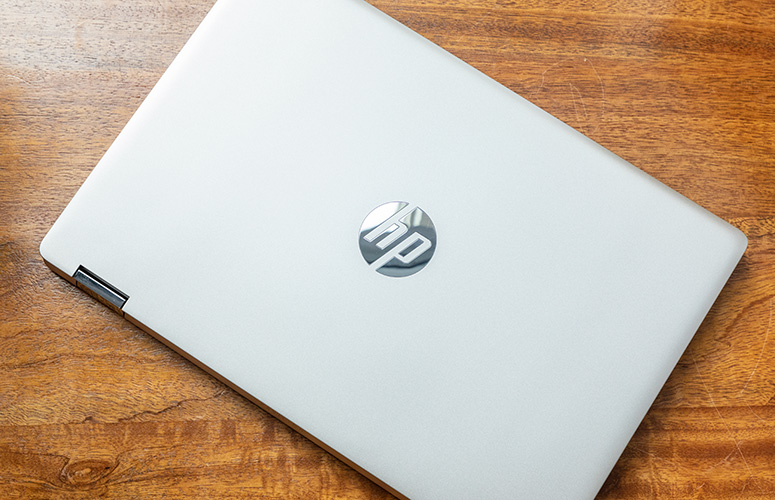
There's also a ton of Windows 10 bloatware, including Candy Crush Saga, Gardenscapes and Asphalt Street Storm Racing.
The Pavilion x360 comes with a one-year limited warranty. See how HP performed on our Tech Support Showdown and Best and Worst Brands ranking.
Bottom Line
The HP Pavilion x360 ($749) is a solid mainstream laptop in that it offers commendable performance, a satisfying keyboard, and some bangin' speakers. But it's tough to get over its short battery life and dull display, especially when you're paying close to premium prices.
For $850, you can get the ZenBook 13, which features a more premium design, stronger performance and a battery that'll let you stay online for more than 11 hours.
But overall, the Pavilion x360 is a decent laptop if you can deal with its short battery life.
Credit: Laptop Mag
HP Pavilion x360 (14-inch) Specs
| Brand | HP |
| CPU | Intel Core i5-8265U processor |
| Display Size | 14 |
| Graphics Card | Intel UHD 620 GPU |
| Hard Drive Size | 128GB SSD |
| Hard Drive Type | SSD |
| Highest Available Resolution | 1920 x 1080 |
| Native Resolution | 1920x1080 |
| RAM | 8GB |
| RAM Upgradable to | 12GB |
| Size | 12.7 x 8.8 x 0.8 inches |
| Touchpad Size | 4.3 x 2.1-inch |
| Warranty/Support | One-year limited warranty |
| Weight | 3.62 pounds |

Rami Tabari is the Reviews Editor for Laptop Mag. He reviews every shape and form of a laptop as well as all sorts of cool tech. You can find him sitting at his desk surrounded by a hoarder's dream of laptops, and when he navigates his way out to civilization, you can catch him watching really bad anime or playing some kind of painfully difficult game. He’s the best at every game and he just doesn’t lose. That’s why you’ll occasionally catch his byline attached to the latest Souls-like challenge.
